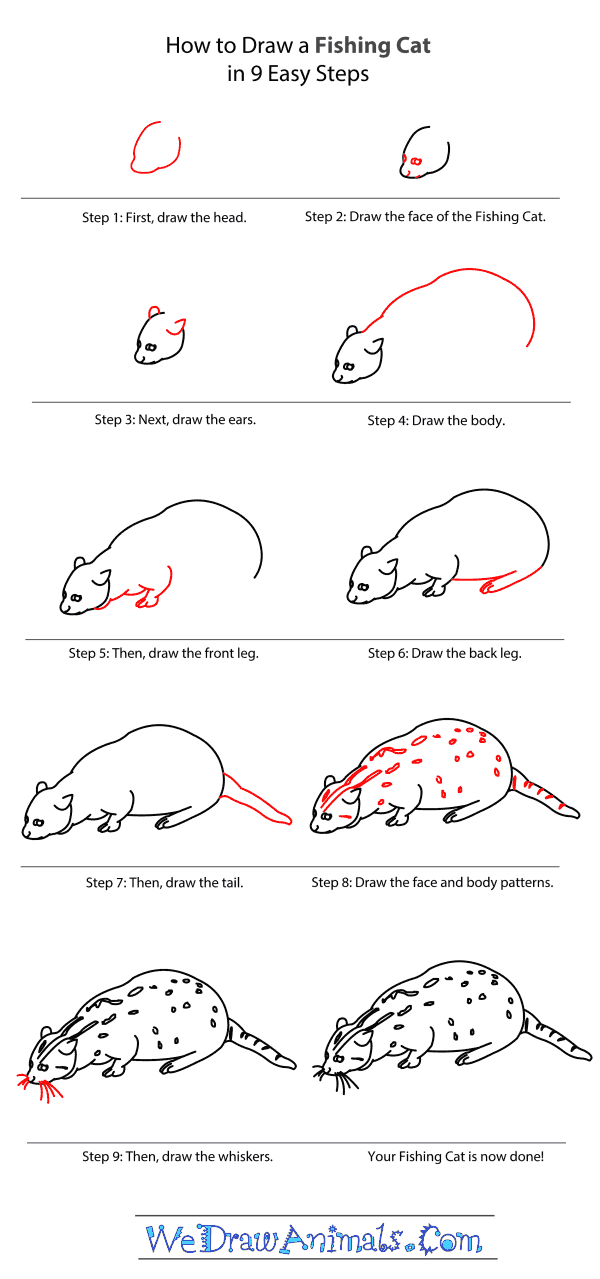In this quick tutorial you'll learn how to draw a Fishing Cat in 9 easy steps - great for kids and novice artists.
The images above represent how your finished drawing is going to look and the steps involved.
Below are the individual steps - you can click on each one for a High Resolution printable PDF version.
At the bottom you can read some interesting facts about the Fishing Cat.
Make sure you also check out any of the hundreds of drawing tutorials grouped by category.
How to Draw a Fishing Cat - Step-by-Step Tutorial
Step 1: First, draw the head. It looks like a crooked "V" with a round bump at the tip.
Step 2: At the very tip of the bottom bump draw a short curved line to make the nose. At the end of that line draw a round black eye. Just to the left of it draw a half an eye against the head line.
Step 3: Along the very top of the head line draw a half circle ear. At the top of the right head line draw a hook shaped ear.
Step 4: From the tip of the top head line draw a long, line up on an angle. Then curve it down in a large arc to make the rump.
Step 5: Draw a bumpy line from the bottom of the head line to make the neck line. At the end of that line draw a line down to make the front leg. Continue down to make the paw with three toes. Finally, draw another curved line up.
Step 6: Continue the rump line down and to the left into the long back leg. The foot has another three toes at the end. Then draw a line joining the top of the back leg to the middle of the front leg.
Step 7: At the right side of the rump line draw two thick lines to make the tail. It angles down and comes to a point at the end.
Step 8: Now draw the fur markings. There are long stripes along the top of the head and short stripes along the tail. Make lots of different sized circles along the back.
Step 9: Finally, draw four whiskers on either side of the snout. The right whiskers are slightly longer than the left whiskers.
Interesting Facts about the Fishing Cat (Prionailurus viverrinus):
The Fishing Cat is a medium-sized wild cat, about twice the size of a domestic feline, with olive grey fur and dark spots that run in horizontal lines across its body and black rings around its tail. The Fishing Cat is muscular and stocky, has a longish face, and has tiny ears set far back on its head. When grown, the Fishing Cat weighs 5-16 kilograms, with a body length of 57-78 centimeters and a tail of an additional 20-30 centimeters. They live in the Asian countries of India, Nepal, Bangladesh, Sri Lanka and Indonesia.
Did you know?
- The Fishing Cat gets its name from its tendency to dive after fish in the water or catch them from above with its paw. This wild cat does not mind getting wet!
- Male Fishing Cats are much larger than females.
- The average life span of a wild Fishing Cat is twelve years, although some have lived over fifteen years in captivity.
- Fishing Cats are most active at night.
- Fishing Cats prefer a solitary lifestyle.
The Fishing Cat is an endangered species. In the past ten years alone, the population of Fishing Cats throughout Asia has experienced a sharp decline. The wetland habitats preferred by the Fishing Cat have been converted, damaged and settled by humans. Another major threat to this species is illegal poaching.










